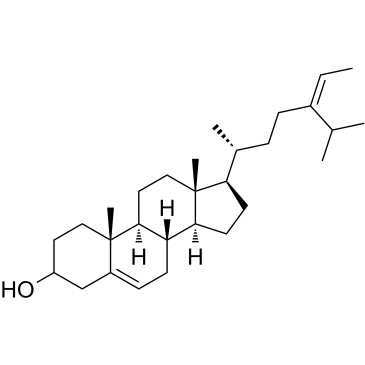Sterol metabolism in the oomycete Aphanomyces euteiches, a legume root pathogen.
Mohammed-Amine Madoui, Justine Bertrand-Michel, Elodie Gaulin, Bernard Dumas
文献索引:New Phytol. 183(2) , 291-300, (2009)
全文:HTML全文
摘要
Sterols are isoprenoid-derived molecules that have essential functions in eukaryotes but whose metabolism remains largely unknown in a large number of organisms. Oomycetes are fungus-like microorganisms that are evolutionarily related to stramenopile algae, a large group of organisms for which no sterol metabolic pathway has been reported. Here, we present data that support a model of sterol biosynthesis in Aphanomyces euteiches, an oomycete species causing devastating diseases in legume crops. In silico analyses were performed to identify genes encoding enzymes involved in the conversion of the isoprenoid precursor 3-hydroxy-3-methylglutaryl coenzyme A to isoprenoids. Several metabolic intermediates and two major sterol end-products were identified by gas chromatography-mass spectroscopy. We show that A. euteiches is able to produce fucosterol (a sterol initially identified in brown algae) and cholesterol (the major animal sterol). Mycelium development is inhibited by two sterol demethylase inhibitors used as fungicides, namely tebuconazole and epoxiconazole. We propose the first sterol biosynthetic pathway identified in a stramenopile species. Phylogenetic analyses revealed close relationships between A. euteiches enzyme sequences and those found in stramenopile algae, suggesting that part of this pathway could be conserved in the Stramenopila kingdom.
相关化合物
| 结构式 | 名称/CAS号 | 分子式 | 全部文献 |
|---|---|---|---|
 |
岩藻甾醇
CAS:17605-67-3 |
C29H48O |
|
Kinetics and molecular docking studies of an anti-diabetic c...
2013-10-25 [Chem. Biol. Interact. 206(1) , 55-62, (2013)] |
|
The effect of traditional stir-frying process on hydrophilic...
2015-01-01 [Int. J. Food Sci. Nutr. 66 , 873-80, (2015)] |
|
Inhibition of Mycobacterium tuberculosis growth by saringost...
2001-11-01 [J. Nat. Prod. 64(11) , 1463-4, (2001)] |
|
Visible fibrinolysis by endothelial cells: effect of vitamin...
1986-12-01 [Biosci. Rep. 6(12) , 1029-33, (1986)] |
|
Biosynthesis of the irregular monoterpene artemisia ketone, ...
2004-09-01 [Phytochemistry 65(17) , 2463-70, (2004)] |